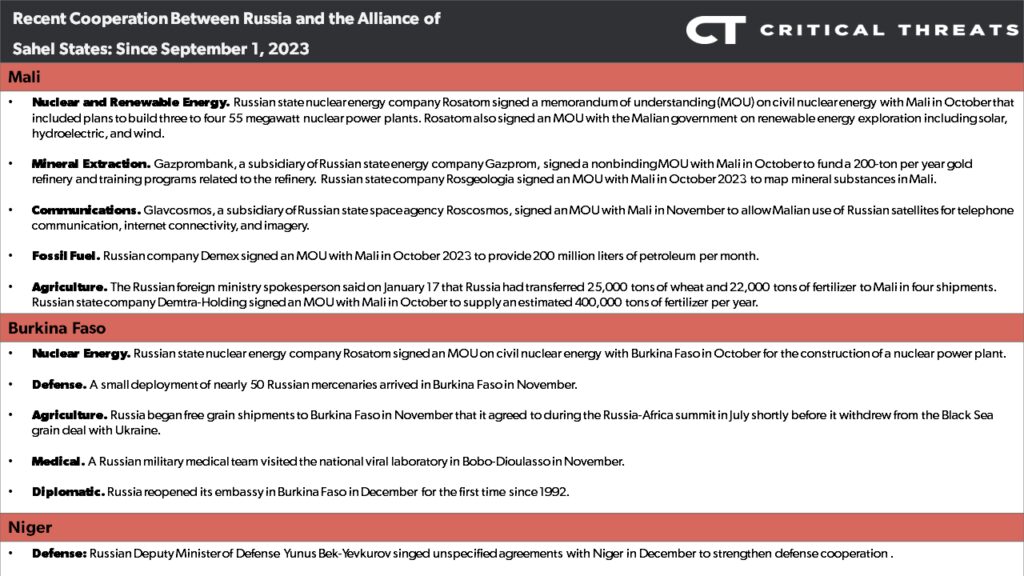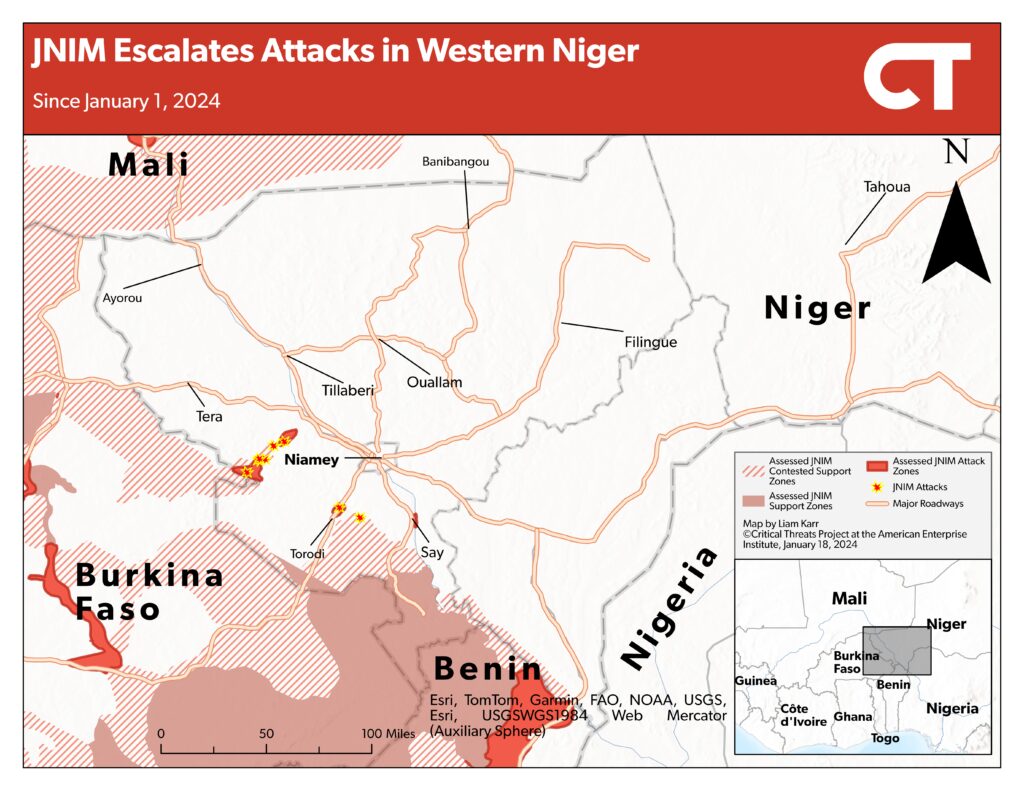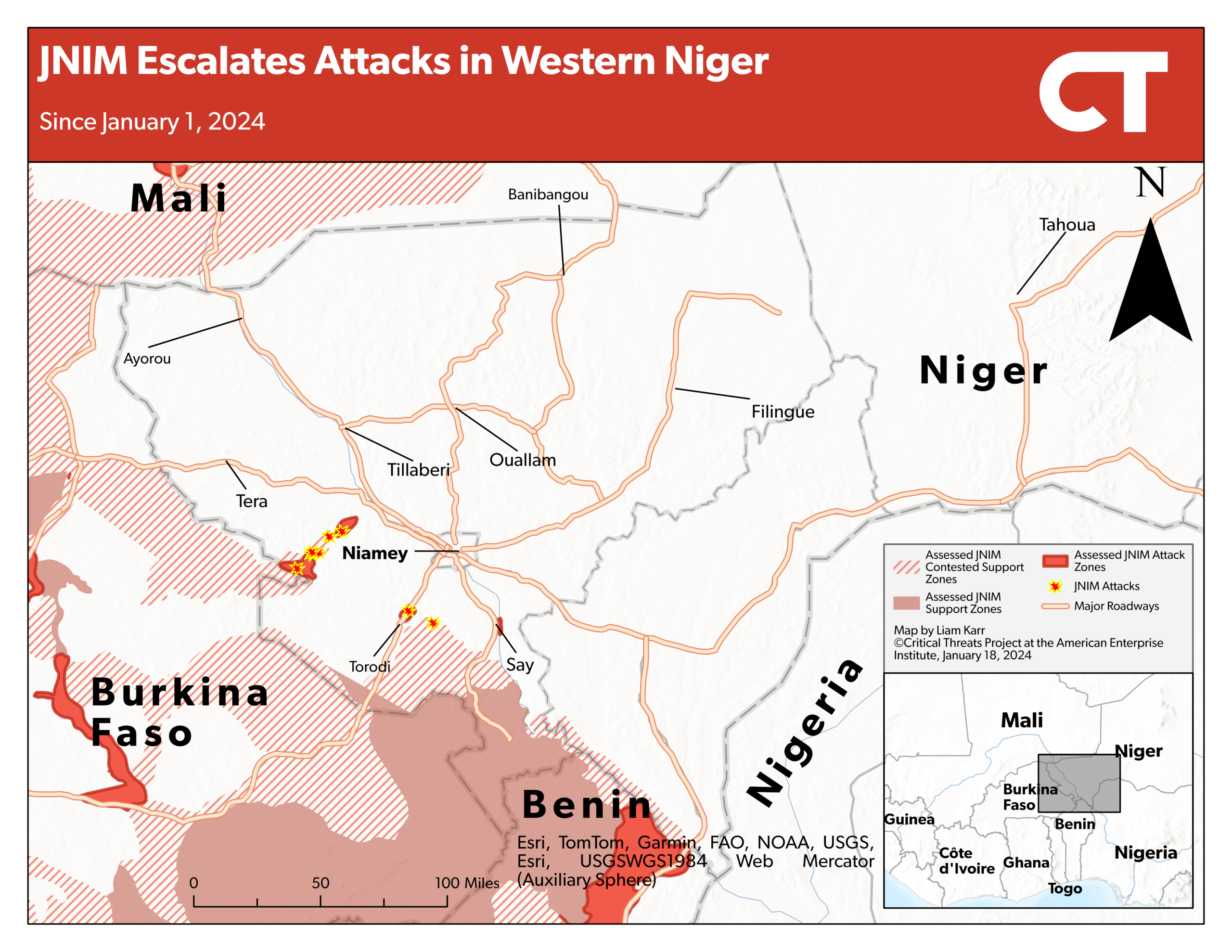Key Takeaway: The Nigerien junta is continuing to grow closer to the Kremlin and may deploy Russian mercenaries in Niger to respond to the deteriorating security situation in the country in the coming months. A significant number of Russian mercenaries would enable the junta to divert Nigerien troops away from the capital to counter al Qaeda–affiliated militants who are strengthening support zones in areas that are enabling attacks within 25 miles of the capital. Russian mercenaries are not effective at counterinsurgency operations and would likely be more focused on advancing the Kremlin’s strategic aims of regime security and resource plunder than counterterrorism operations. The junta could alternatively pursue a more traditional defense partnership with Russia and rely on civilian militias to augment its capacity outside the capital. The uses of Russian mercenaries and civilian militias are not mutually exclusive, but either option will likely exacerbate human rights abuses that push locals to ally with insurgents for protection.
Nigerien and Russian officials are meeting in Moscow to strengthen their relationship in various fields, including defense and nuclear energy. A Nigerien ministerial delegation arrived in Moscow on January 15 to discuss defense, energy, agriculture, and healthcare cooperation with Russian officials.[1] The trip comes shortly after Russian Deputy Defense Minister Yunus-Bek Yevkurov visited Niger and signed unspecified defense agreements with junta leaders in early December.[2]
Russia signed several other deals with the Burkinabe, Malian, and Nigerien juntas in the fourth quarter of 2023; these countries comprise the pro-Russian bloc of authoritarian states in the Sahel known as the Alliance of Sahel States (AES). Russian state-owned energy company Rosatom signed memorandums of understanding (MOU) with the Burkinabe and Malian juntas in October 2023 to expand civil nuclear energy exploration, including the construction of nuclear power plants.[3] Malian officials also signed several more MOUs during a ministerial delegation visit to Moscow with Russian state-owned companies on renewable energy, petroleum provision, and mineral extraction.[4]
Figure 1. Recent Cooperation Between Russia and the Alliance of Sahel States

Source: Liam Karr; https://africaincome dot com/2023/10/mali-russie-un-nouveau-cap-franchi-dans-la-cooperation-bilaterale; https://www.reuters.com/markets/commodities/mali-signs-agreement-with-russia-build-gold-refinery-2023-11-22; https://en.sputniknews dot africa/20231120/russian-space-agency-to-provide-satellite-to-mali-1063675193.html; https://www.bbc.com/news/world-africa-67833215; https://alleyesonwagner.org/2023/12/04/opa-russe-sur-le-burkina; https://www.barrons.com/news/russian-officials-visit-niger-to-bolster-military-ties-1933bc3e
The Kremlin has continued growing its ties with the Sahelian juntas as Western and international forces have decreased their engagement. The decade-long UN peacekeeping mission in Mali ended in December 2023, over a year after French soldiers withdrew from Mali after fighting Salafi-jihadi insurgents for nine years.[5] France also completed withdrawing its forces from Niger in December 2023 and indefinitely closed its embassy in Niger on January 2.[6] The United States has remained in Niger but has nearly halved its force presence from 1,000 to 650 troops since September, has cut all non-humanitarian aid, and is exploring alternative basing in the Gulf of Guinea that could replace its Niger bases.[7]
The Nigerien-Russian meetings in Moscow come as al Qaeda–linked militants are increasing their attacks in western Niger in January, including two attacks less than 25 miles from the city limits of the Nigerien capital. Al Qaeda’s Sahelian affiliate Jama’at Nusrat al Islam wa al Muslimeen (JNIM) has conducted at least eight attacks in Niger in January after conducting zero attacks in December.[8] The attacks have primarily occurred in two areas where JNIM has been active throughout 2023: the Samira area of the Gotheye department and the Torodi-Say axis.
JNIM likely aims to strengthen its support zones west of the capital. The group carried out at least six attacks around Samira—which has a gold mine—that have inflicted a heavy toll on civilians. Three of these attacks targeted Nigerien forces stationed in or traveling to the area.[9] Nigerien air support mistakenly targeted civilians after one of the attacks and killed at least 50 people.[10] Two other JNIM attacks directly targeted civilians, likely in retaliation for militia mobilization against JNIM, including a clash that killed at least 34 Djerma militia fighters.[11] These types of operations signal that JNIM is aiming to remove Nigerien forces from the area and coerce civilians so it can ensure freedom of movement, gain access to resources, and establish logistical and administrative basing.
The group conducted at least two more attacks within 25 miles of the Nigerien capital along the roads connecting Niamey and the district capitals of Torodi and Say. At least 20 JNIM fighters attacked a gendarmerie post along the RN6 road between Torodi and Niamey, killing at least three civilians in the crossfire and stealing several vehicles from the post.[12] A civilian cyclist also struck a JNIM improvised explosive device (IED) along the road between Torodi and Say.[13] JNIM first established a haven in the villages between Torodi and Say weeks before the July 2023 coup.[14] The gendarmerie post raid and IED indicate that JNIM has maintained a support zone where it can stage fighters and manufacture IEDs along this axis. The January IED and other IEDs and ambushes targeting patrolling Nigerien forces in September 2023 also signal an effort to keep security forces out of these havens.[15]
Figure 2. JNIM Escalates Attacks in Western Niger

Source: Liam Karr.
Strengthened support zones would enable JNIM to amplify pressure on the roads surrounding Niamey during the coming year. Samira and the Torodi-Say axis are near key roads leading to the capital. JNIM has already used its havens along the Torodi-Say axis to attack the RN6 connecting Torodi and Niamey. The same havens could facilitate attacks on the RN27, which connects Say and Niamey. Support zones in the Gotheye department would also enable attacks along the RN1 or RN4 highways that run along the Niger River and connect several department capitals in northwestern Niger to Niamey. JNIM has not made any statements that it is imminently planning an offensive on Niamey itself and has historically avoided decisive battles for large population centers in favor of siege tactics that isolate security forces and spur favorable negotiations.[16]
Attacks near the capital would delegitimize the Nigerien government and presumably preoccupy the junta with improving security near the capital, reducing pressure on the insurgents’ havens near the border. JNIM similarly used havens in central Mali to conduct a campaign targeting key roadways around the Malian capital in southern Mali throughout 2023.[17] JNIM highlights its attacks near politically sensitive areas to challenge the government’s authority and demonstrate authorities’ failure to contain the group.[18] These attacks especially undermine the juntas given that their legitimacy is rooted in combating the Salafi-jihadi threat after using insecurity to justify their coups.[19] Targeting roadways around Niamey would also harm commercial activity along these vital arteries, which would further increase popular discontent with the junta.
Niger may contract Russian mercenaries to help fill capacity gaps left by the Western departure from Niger and address the deteriorating security situation. Russian mercenaries are already present in the neighboring AES countries, with at least 1,000 Kremlin-funded Wagner Group personnel in Mali and a much smaller deployment of Russian mercenaries in Burkina Faso.[20] The Nigerien junta also initially showed interest in a Wagner Group deployment in its first days in power, although this was when it faced a potential regional invasion to restore democratic rule.[21] The Kremlin increased its engagement with the Sahelian juntas after the July 2023 Wagner rebellion as part of its effort to take over and replace the Wagner Group.[22] Open-source intelligence organizations have assessed that the Russian Ministry of Defense began ramping up recruitment in the fourth quarter of 2023 for a new private military company called “Africa Corps” that aims to establish footholds in Burkina Faso and Niger and subsume preexisting Wagner operations in other countries such as Libya and Mali.[23]
Nigerien officials signed unspecified defense agreements with Russia during Deputy Defense Minister Yevkurov’s visit in December 2023.[24] Reputable Spain-based Sahelian open-source researcher Abdou Pagoui claimed that the documents included a pre-agreement to a Russian mercenary deployment in advance of the current meetings in Moscow.[25] One of the pro-Russian junta leaders met with Deputy Defense Ministers Yevkurov and Alexander Fomin on January 16 as part of the ministerial visit to discuss bilateral military and military-technical cooperation.[26]
Russian mercenaries in Africa have been ineffective in counterinsurgency operations and would likely be more focused on advancing the Kremlin’s strategic aims of regime security and resource plunder than degrading insurgent support zones in western Niger. Wagner Group forces spectacularly failed to slow the Salafi-jihadi insurgency in Mozambique in 2019 and have failed to degrade the Salafi-jihadi insurgency in Mali.[27] The Wagner contingent’s size is insufficient to address the insurgency in Mali, given its force composition is roughly 6 percent of the struggling French and UN troops it replaced.[28] Wagner’s brutal tactics are also counterproductive, as they exacerbate human rights abuses against civilians that insurgent groups use to gain popular support.[29] However, a significant Wagner presence around Niamey would improve the Nigerien forces’ capacity and enable the junta to divert more troops away from the capital.
Regime protection and resource plunder advance the Kremlin’s strategic goals of supporting pro-Russian dictators and acquiring natural resources that help mitigate Western sanctions for its invasion of Ukraine.[30] Wagner’s most significant contributions in Mali have been to symbolic victories in northern Mali that have shored up regime security and positioned its Wagner fighters near northern Mali’s artisanal gold mines.[31] The small mercenary force in Burkina Faso focuses on regime security and training of elite units and does not directly engage in counterinsurgency operations.[32]
Niger could alternatively pursue more limited defense partnerships with Russia and rely on civilian militias to augment its capacity outside the capital. Niger’s AES partner Burkina Faso has so far avoided a large Russian mercenary deployment and focused on expanding civilian militia groups and formalizing joint operations between the militia and military forces to improve its capacity.[33] The Burkinabe junta recruited 50,000 such auxiliaries in October 2022 and has continued trying to expand the militia by increasing salaries through fundraising and new taxes in 2023 and 2024.[34]
Civilian self-defense militias in peripheral areas along Niger’s borders have a long history of mobilizing against Salafi-jihadi insurgents in the government’s absence.[35] Niger’s government formally allied with Malian pro-government militias against Islamic State fighters in 2017 before cutting ties due to a counterproductive increase in ethnic-based violence. Niger’s previous democratic administrations had since tried to discourage militia formation to decrease ethnic-based violence, with varying degrees of success.[36]
Local reports on TikTok and X—formerly known as Twitter—claimed that several self-defense militias mobilized in early January 2024.[37] The Nigerien government has not made any measures or statements to formally mobilize militias under government direction against Salafi-jihadi insurgents as seen in Burkina Faso, but it did briefly encourage the creation of small volunteer militias when it was trying to consolidate control and discourage a regional intervention in August 2023.[38]
The uses of civilian militias and Russian mercenaries are not mutually exclusive, but either option will likely exacerbate human rights abuses that push locals to ally with insurgents for protection. Civilian militias in Niger have historically sparked retaliatory cycles of ethnic violence that Salafi-jihadi groups exploit to pose as a local protector and recruit from affected populations.[39] Civilian militias in Burkina Faso and Mali have similarly carried out human rights abuses and ethnic-based violence, which benefits Salafi-jihadi militants.[40] Wagner’s established pattern of human rights abuses across its various theaters would also boost the insurgents’ popular support.[41]
Potential divisions within the junta could lead to internal power struggles that would affect Niger’s decision-making. Researcher Abdou Pagoui claimed that key junta officials are split on a potential Russian mercenary deployment.[42] Pagoui reported that Generals Salifou Modi and Mohamed Toumba favor a deal because they believe a Wagner deployment will replace the specialized training and management that Western forces provided.[43] According to Pagoui, General Moussa Barmou and Colonel Mamane Kiou are anti-Wagner because they believe a mercenary contract will be too expensive and would undermine their legitimacy and image by relying on foreign powers.[44] General Barmou has extensive ties to US military and political officials, spent time in the United States over the previous three decades, and was a key diplomatic channel in the days following the July 2023 coup.[45] Pagoui said that the anti-Wagner camp has the support of roughly 80 percent of the officer corps.[46]

